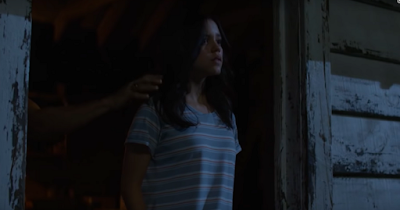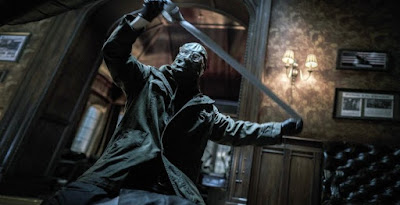And now our most recent cycle of horror reboots comes for The Texas Chain Saw Massacre, Tobe Hooper’s 1974 genre landmark. The 2022 iteration, called Texas Chainsaw Massacre (drop the article, close the space), ignores all other attempts to continue the original story in order to claim status as a real continuation, like David Gordon Green’s Halloweens. It catches up with Leatherface, the hulking masked brute wielding the murder weapon of the title, who is about to unleash terror once again after decades sitting dormant. You see, instead of youths in a van stumbling into a murderous family’s house in the middle-of-nowhere Texas, there are social media influencers coming to his small dead-end Texas town in hopes of revitalizing it. Easy targets, no? Director David Blue Garcia, from a screenplay in part by Fede Alvarez and collaborators who did the excellently vomitous Evil Dead reboot, uses the premise to stage a predictable slasher picture that never gets out of the shadow of its vastly superior inspiration.
It puts in a slick effort, though. Too slick is more like it. The new cast (like Sarah Yarkin, Elsie Fisher, and Jacob Latimore) is quickly characterized as troubled and idealistic youths. They’re waiting on a bus of tech investors and streaming stars to help them buy up the town, in the process accidentally displacing the unfortunate Leatherface. Eventually they’re joined by returning final girl Sally Hardesty (Olwen Fouere), grey-haired and ready to fight, having evidently taken her lifestyle cues from Jamie Lee Curtis’ Laurie. (Isn’t it more than a little depressing that such thrilling survivors are constantly shown in these sort of follow-ups to be stuck in place waiting for a sequel well into their elderly years?) Garcia directs the ensemble through a routine number of slaughter sequences, with tons of splatter and viscera, including sloppy disembowelments and spraying decapitations, often carried out with bloody convincing and coldly detailed makeup effects that are certainly a mark of talented craft. But attempts to update its premise are laughable. One guy live-streaming Leatherface declares, “if you do anything, you’re cancelled, bro.” And there may be no more sad commentary on the drop from the original than a final moment riffing on the iconic back-of-the-pickup-truck gasp of cathartic laughing screams that trades it in for a Tesla self-driving into the sunset with its passenger staring helplessly back.
But these filmmakers run into the same problem that all who attempt to follow up the original eventually encounter. Their movies inevitably feel just like movies. Turns out, each new Massacre emphasizes all the more that Hooper’s original isn’t merely a movie, but an unreplicable nightmare. It’s a deceptively crafty work of extreme low-budget ingenuity that resulted in something that plays, to this day, as a work of filmmaking that feels less like a movie, and more dangerously real, with judicious gore, perfectly amateur performances that are plain and raw, and implied terrors so upsetting just outside the frame that the whole picture plays as if its jagged edges threaten to tear loose from the sprocket holes and burn away before our very eyes. Its smallness and its suggestion, combined with its seemingly unaffected naturalism and rough-hewn design, make it so purposely rough and unformed that it truly does feel like anything’s possible. There’s real danger in it. This latest attempt is simply a proficient gore machine, running through the motions, gliding easily down a path the original tore open. It is too neatly packaged to feel truly dangerous.
The film’s conceit locates the intersection between grungy horror and narrative porn, two types of variably disreputable filmmaking bubbling out of the midcentury indie film markets, built on teasing suspense, suggestive editing, and goading audience reactions with sudden explicit reveals. They each, in their eye-popping way, make use of what Berkeley film professor Linda Williams calls “the frenzy of the visible.” They’ve also long had the most, ahem, robust amateur scenes. Especially in the 70s’ regional cinemas (from whence we get Hooper as well as other horror-makers Romero and Craven and Raimi), both genres found purchase in the extremes of mainstream acceptability or just beyond—and, in retrospect, that both had viable theatrical models at the time is almost unbelievable to consider from their current cultural position. Back then, ambitious filmmakers could scrounge up a shoestring budget, and find their rough-hewn howls of creativity speckled with real ingenuity driven by a desire to grab attention. That’s what makes a breeding ground for greedy hucksters and thoughtful artists alike, bound together by exploitation concepts, dubious financing, and corner-cutting illegalities, ultimately becoming the foundation for the boom of American indies in the decades after.
By setting his new movie in the 70s, West sells it partially as a tribute to the entrepreneurial spirt of low-budget moviemaking. The director in the movie (Owen Campbell) says he wants to do more than give the audience what they want, experimenting with the editing “like the French do.” (West obliges, by giving X some stutter-step transitions between scenes and a beautifully ominous split-screen music montage rising action just before things go from bad to worse.) This independent filmmaker brings along his girlfriend (Jenna Ortega) to operate the sound equipment. She didn’t know what kind of movie they’d be making, and is off-put, but also a little surprised how much she likes seeing the performances in front of the camera. The smarmy producer (Martin Henderson) just wants to strike it rich, and make his fiancé (Mia Goth) a sex symbol. The other performers (Brittany Snow and Scott Mescudi) just want to celebrate something they enjoy, and enjoy sharing. West shows us the satisfaction they all take with the creativity, not just the physical act, of their art. They enjoy framing shots and talking ideas for new scenes. They own up with a frankness to their pursuits, and are eager to have their work seen by the masses. After all, they say, why not have fun before they’re too old. “To the perverts!” they toast after their first day of filming, in a sequence of cozy camaraderie that the film’s promised bloodbath drawing closer makes inescapably melancholy.
The back half of X is devoted to the backgrounded creepiness of the old couple escalating to deadly consequences. This results in a series of creatively gross murder sequences, with bodies penetrated by knives and pitchforks and nails and gunfire and…well, I won’t spoil them all. The effects are good gooey gore, with the makeup work on wounds, torn flesh, and fragmented bones cringingly well-done. And the ways West builds suspense and release with jumps and twists—some people die in exactly the way it looks like they will, while others have more sudden or surprising exits—are satisfying in a jolting horror movie style. The more we see of the elderly duo who are resentful of these beautiful young libertines and only grow more so the more they see of them—quite literally—the more it’s clear they’re acting out of deeply repressed or thwarted desires of their own. West pushes a bit too hard on the fright factor of the elderly—I’m not sure wrinkly skin and various dermatological issues are as inherently icky as the movie leans on—but their behavior makes them suitably, pathetically villainous. Everyone has their role. Overall, it’s a horror movie in love with being a horror movie, playing with tropes throughout. There’s evident delight taken in setting up a charismatic cast we hate to see slaughtered and then admire how the filmmaker pulls it off. It may be no less predictable or derivative for it, but the affection shines through every satisfying twist of the plot—and the knife.









